Youth Justice: Public Opinion, Classical and Strain Theories
VerifiedAdded on 2019/10/31
|8
|2203
|643
Essay
AI Summary
This essay delves into the multifaceted issue of youth justice, focusing on public opinion regarding juvenile delinquency in Australia. It analyzes how public commentaries, particularly those responding to proposed changes in Queensland's parliament, reflect the classical theory's perspective, which posits that youths make rational choices to commit crimes. The essay contrasts these views with academic literature and the strain theory, which considers social factors like economic hardships and ineffective policies as drivers of youth offending. It examines the debate surrounding punitive measures such as naming and shaming versus rehabilitative approaches, highlighting the discrepancies between public sentiment and scholarly findings. The essay references several studies to support the arguments and concludes by emphasizing the complexity of youth crime and the need for an inclusive policy approach that considers both individual choices and societal influences. The analysis underscores the ongoing tension between public demand for punishment and the academic emphasis on understanding and addressing the underlying causes of youth delinquency.
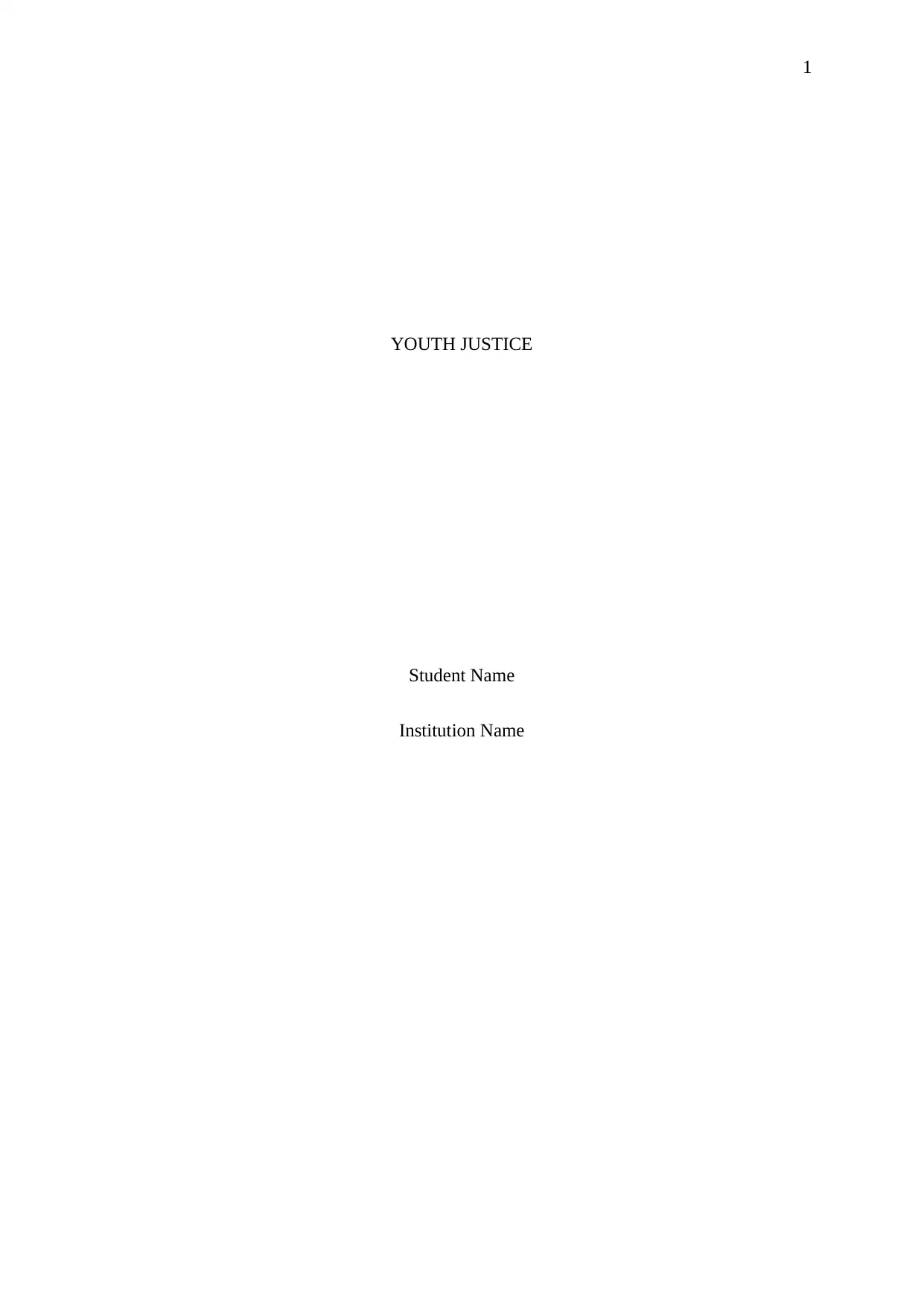
1
YOUTH JUSTICE
Student Name
Institution Name
YOUTH JUSTICE
Student Name
Institution Name
Paraphrase This Document
Need a fresh take? Get an instant paraphrase of this document with our AI Paraphraser
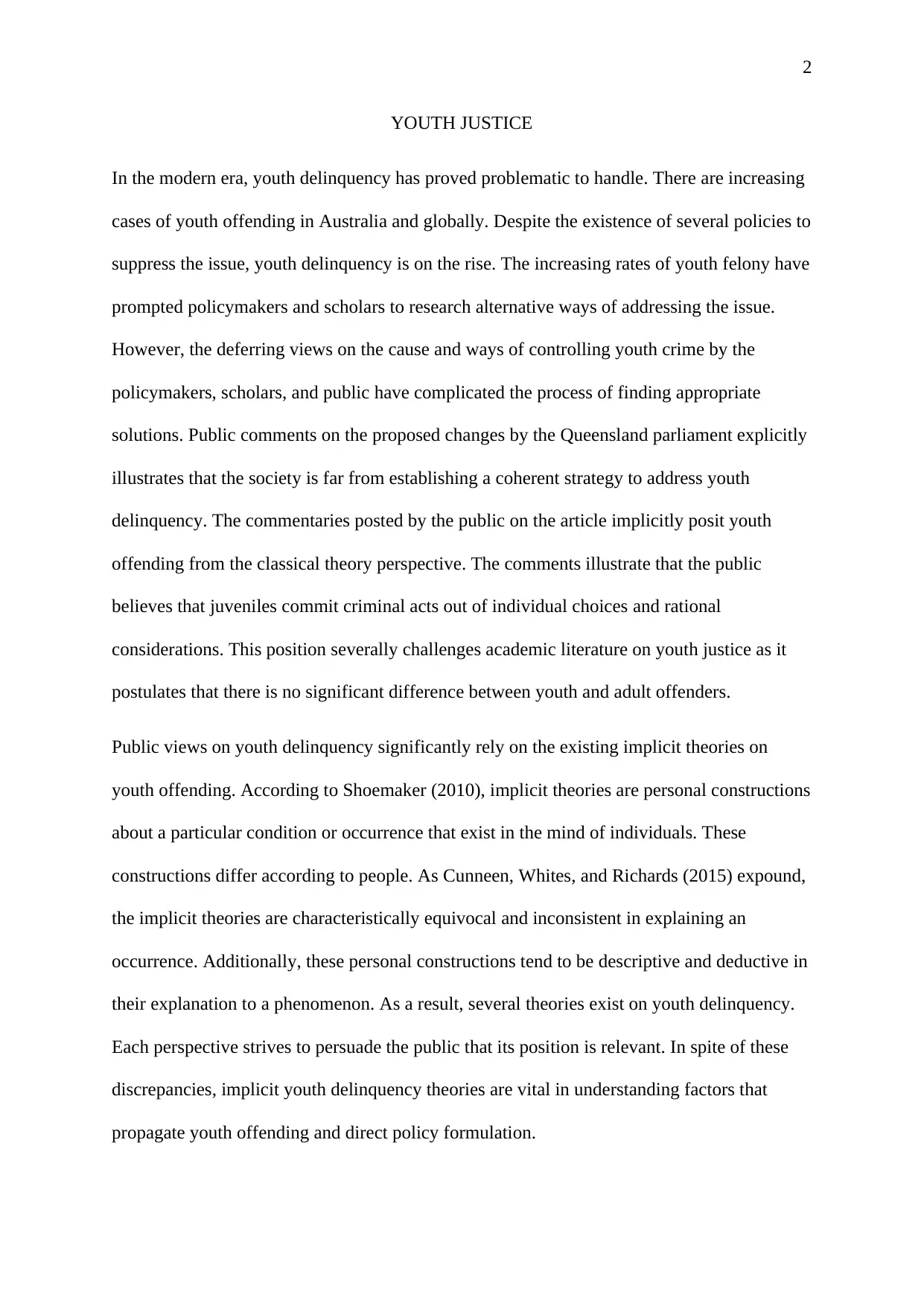
2
YOUTH JUSTICE
In the modern era, youth delinquency has proved problematic to handle. There are increasing
cases of youth offending in Australia and globally. Despite the existence of several policies to
suppress the issue, youth delinquency is on the rise. The increasing rates of youth felony have
prompted policymakers and scholars to research alternative ways of addressing the issue.
However, the deferring views on the cause and ways of controlling youth crime by the
policymakers, scholars, and public have complicated the process of finding appropriate
solutions. Public comments on the proposed changes by the Queensland parliament explicitly
illustrates that the society is far from establishing a coherent strategy to address youth
delinquency. The commentaries posted by the public on the article implicitly posit youth
offending from the classical theory perspective. The comments illustrate that the public
believes that juveniles commit criminal acts out of individual choices and rational
considerations. This position severally challenges academic literature on youth justice as it
postulates that there is no significant difference between youth and adult offenders.
Public views on youth delinquency significantly rely on the existing implicit theories on
youth offending. According to Shoemaker (2010), implicit theories are personal constructions
about a particular condition or occurrence that exist in the mind of individuals. These
constructions differ according to people. As Cunneen, Whites, and Richards (2015) expound,
the implicit theories are characteristically equivocal and inconsistent in explaining an
occurrence. Additionally, these personal constructions tend to be descriptive and deductive in
their explanation to a phenomenon. As a result, several theories exist on youth delinquency.
Each perspective strives to persuade the public that its position is relevant. In spite of these
discrepancies, implicit youth delinquency theories are vital in understanding factors that
propagate youth offending and direct policy formulation.
YOUTH JUSTICE
In the modern era, youth delinquency has proved problematic to handle. There are increasing
cases of youth offending in Australia and globally. Despite the existence of several policies to
suppress the issue, youth delinquency is on the rise. The increasing rates of youth felony have
prompted policymakers and scholars to research alternative ways of addressing the issue.
However, the deferring views on the cause and ways of controlling youth crime by the
policymakers, scholars, and public have complicated the process of finding appropriate
solutions. Public comments on the proposed changes by the Queensland parliament explicitly
illustrates that the society is far from establishing a coherent strategy to address youth
delinquency. The commentaries posted by the public on the article implicitly posit youth
offending from the classical theory perspective. The comments illustrate that the public
believes that juveniles commit criminal acts out of individual choices and rational
considerations. This position severally challenges academic literature on youth justice as it
postulates that there is no significant difference between youth and adult offenders.
Public views on youth delinquency significantly rely on the existing implicit theories on
youth offending. According to Shoemaker (2010), implicit theories are personal constructions
about a particular condition or occurrence that exist in the mind of individuals. These
constructions differ according to people. As Cunneen, Whites, and Richards (2015) expound,
the implicit theories are characteristically equivocal and inconsistent in explaining an
occurrence. Additionally, these personal constructions tend to be descriptive and deductive in
their explanation to a phenomenon. As a result, several theories exist on youth delinquency.
Each perspective strives to persuade the public that its position is relevant. In spite of these
discrepancies, implicit youth delinquency theories are vital in understanding factors that
propagate youth offending and direct policy formulation.
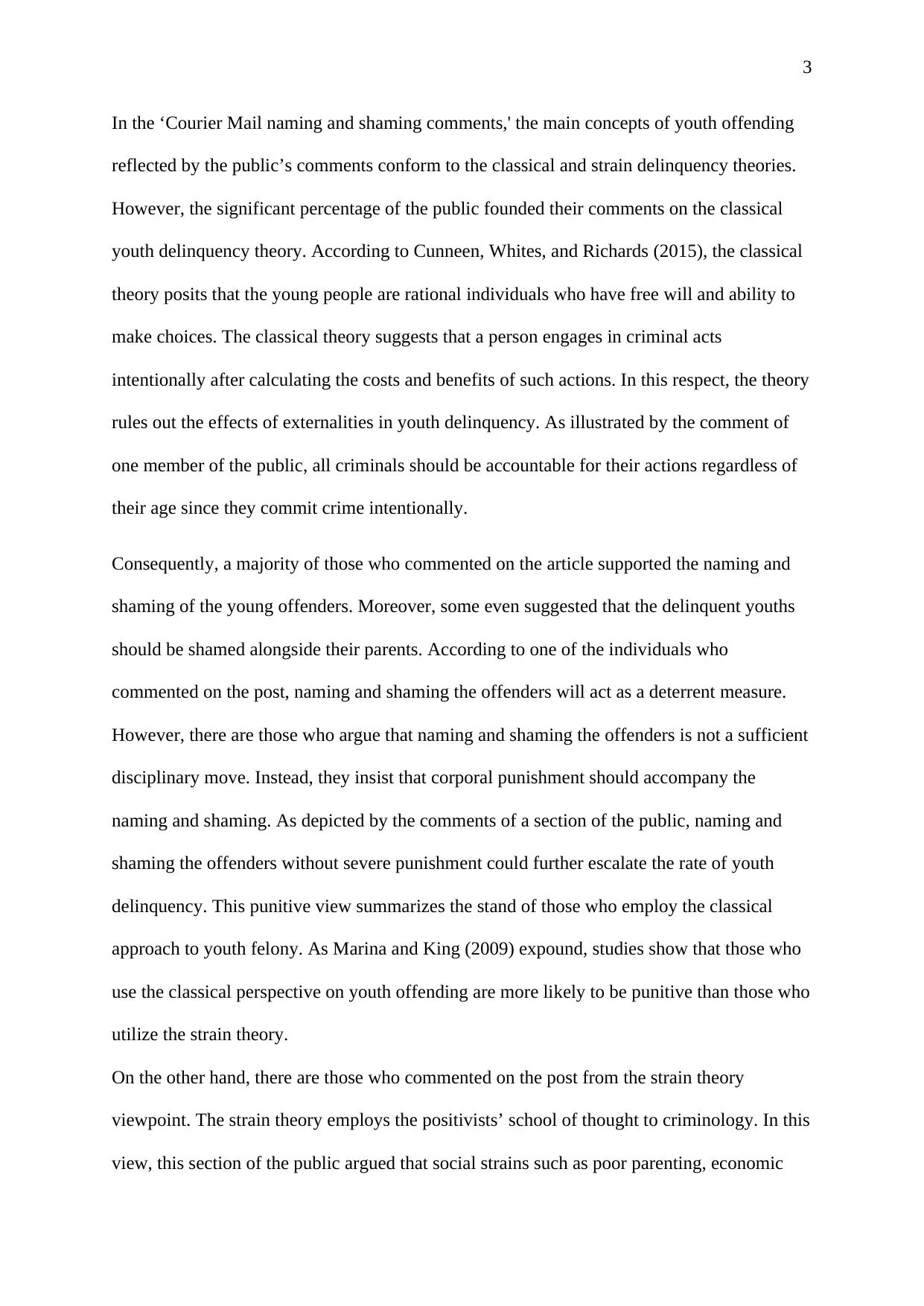
3
In the ‘Courier Mail naming and shaming comments,' the main concepts of youth offending
reflected by the public’s comments conform to the classical and strain delinquency theories.
However, the significant percentage of the public founded their comments on the classical
youth delinquency theory. According to Cunneen, Whites, and Richards (2015), the classical
theory posits that the young people are rational individuals who have free will and ability to
make choices. The classical theory suggests that a person engages in criminal acts
intentionally after calculating the costs and benefits of such actions. In this respect, the theory
rules out the effects of externalities in youth delinquency. As illustrated by the comment of
one member of the public, all criminals should be accountable for their actions regardless of
their age since they commit crime intentionally.
Consequently, a majority of those who commented on the article supported the naming and
shaming of the young offenders. Moreover, some even suggested that the delinquent youths
should be shamed alongside their parents. According to one of the individuals who
commented on the post, naming and shaming the offenders will act as a deterrent measure.
However, there are those who argue that naming and shaming the offenders is not a sufficient
disciplinary move. Instead, they insist that corporal punishment should accompany the
naming and shaming. As depicted by the comments of a section of the public, naming and
shaming the offenders without severe punishment could further escalate the rate of youth
delinquency. This punitive view summarizes the stand of those who employ the classical
approach to youth felony. As Marina and King (2009) expound, studies show that those who
use the classical perspective on youth offending are more likely to be punitive than those who
utilize the strain theory.
On the other hand, there are those who commented on the post from the strain theory
viewpoint. The strain theory employs the positivists’ school of thought to criminology. In this
view, this section of the public argued that social strains such as poor parenting, economic
In the ‘Courier Mail naming and shaming comments,' the main concepts of youth offending
reflected by the public’s comments conform to the classical and strain delinquency theories.
However, the significant percentage of the public founded their comments on the classical
youth delinquency theory. According to Cunneen, Whites, and Richards (2015), the classical
theory posits that the young people are rational individuals who have free will and ability to
make choices. The classical theory suggests that a person engages in criminal acts
intentionally after calculating the costs and benefits of such actions. In this respect, the theory
rules out the effects of externalities in youth delinquency. As illustrated by the comment of
one member of the public, all criminals should be accountable for their actions regardless of
their age since they commit crime intentionally.
Consequently, a majority of those who commented on the article supported the naming and
shaming of the young offenders. Moreover, some even suggested that the delinquent youths
should be shamed alongside their parents. According to one of the individuals who
commented on the post, naming and shaming the offenders will act as a deterrent measure.
However, there are those who argue that naming and shaming the offenders is not a sufficient
disciplinary move. Instead, they insist that corporal punishment should accompany the
naming and shaming. As depicted by the comments of a section of the public, naming and
shaming the offenders without severe punishment could further escalate the rate of youth
delinquency. This punitive view summarizes the stand of those who employ the classical
approach to youth felony. As Marina and King (2009) expound, studies show that those who
use the classical perspective on youth offending are more likely to be punitive than those who
utilize the strain theory.
On the other hand, there are those who commented on the post from the strain theory
viewpoint. The strain theory employs the positivists’ school of thought to criminology. In this
view, this section of the public argued that social strains such as poor parenting, economic
⊘ This is a preview!⊘
Do you want full access?
Subscribe today to unlock all pages.

Trusted by 1+ million students worldwide
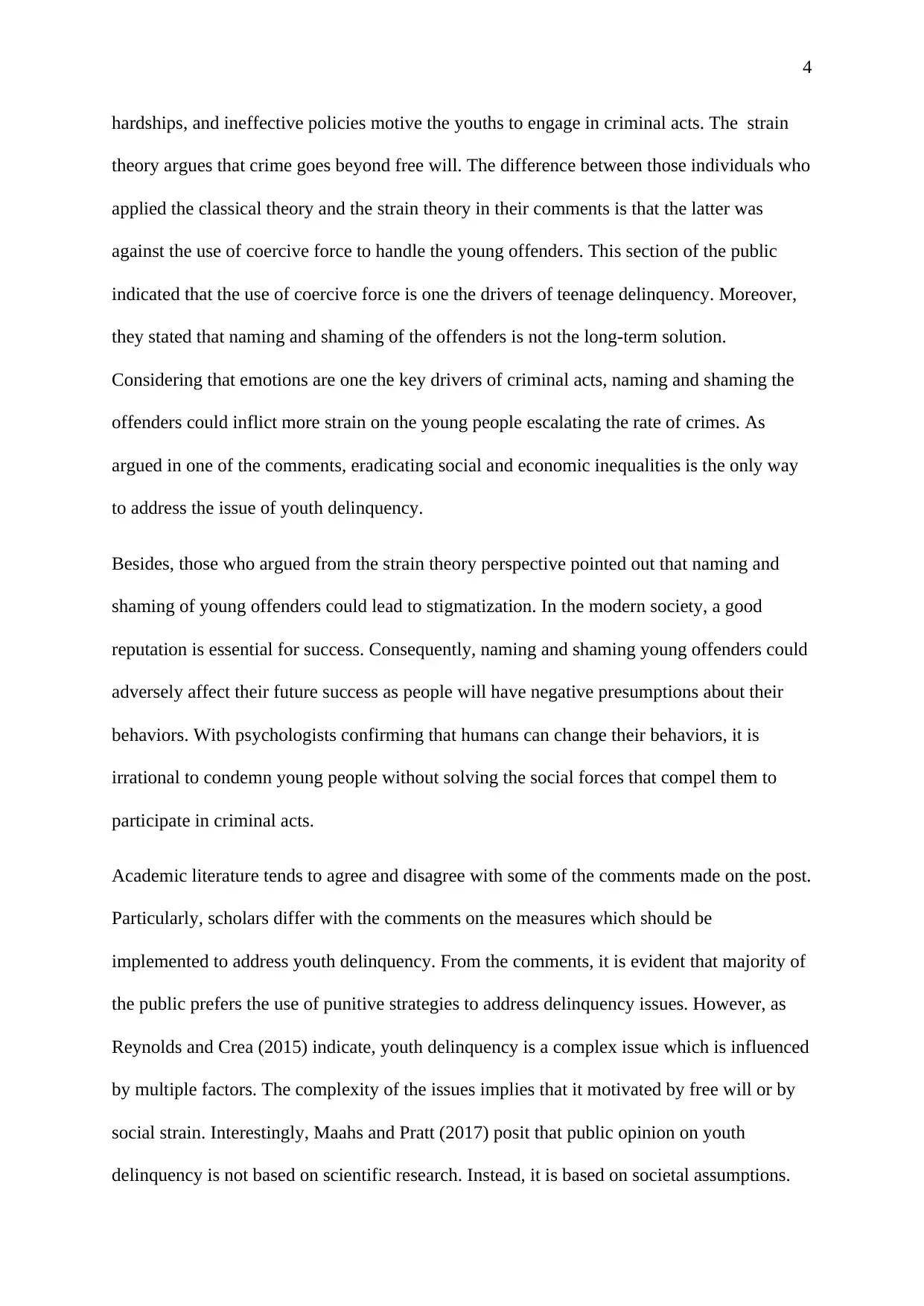
4
hardships, and ineffective policies motive the youths to engage in criminal acts. The strain
theory argues that crime goes beyond free will. The difference between those individuals who
applied the classical theory and the strain theory in their comments is that the latter was
against the use of coercive force to handle the young offenders. This section of the public
indicated that the use of coercive force is one the drivers of teenage delinquency. Moreover,
they stated that naming and shaming of the offenders is not the long-term solution.
Considering that emotions are one the key drivers of criminal acts, naming and shaming the
offenders could inflict more strain on the young people escalating the rate of crimes. As
argued in one of the comments, eradicating social and economic inequalities is the only way
to address the issue of youth delinquency.
Besides, those who argued from the strain theory perspective pointed out that naming and
shaming of young offenders could lead to stigmatization. In the modern society, a good
reputation is essential for success. Consequently, naming and shaming young offenders could
adversely affect their future success as people will have negative presumptions about their
behaviors. With psychologists confirming that humans can change their behaviors, it is
irrational to condemn young people without solving the social forces that compel them to
participate in criminal acts.
Academic literature tends to agree and disagree with some of the comments made on the post.
Particularly, scholars differ with the comments on the measures which should be
implemented to address youth delinquency. From the comments, it is evident that majority of
the public prefers the use of punitive strategies to address delinquency issues. However, as
Reynolds and Crea (2015) indicate, youth delinquency is a complex issue which is influenced
by multiple factors. The complexity of the issues implies that it motivated by free will or by
social strain. Interestingly, Maahs and Pratt (2017) posit that public opinion on youth
delinquency is not based on scientific research. Instead, it is based on societal assumptions.
hardships, and ineffective policies motive the youths to engage in criminal acts. The strain
theory argues that crime goes beyond free will. The difference between those individuals who
applied the classical theory and the strain theory in their comments is that the latter was
against the use of coercive force to handle the young offenders. This section of the public
indicated that the use of coercive force is one the drivers of teenage delinquency. Moreover,
they stated that naming and shaming of the offenders is not the long-term solution.
Considering that emotions are one the key drivers of criminal acts, naming and shaming the
offenders could inflict more strain on the young people escalating the rate of crimes. As
argued in one of the comments, eradicating social and economic inequalities is the only way
to address the issue of youth delinquency.
Besides, those who argued from the strain theory perspective pointed out that naming and
shaming of young offenders could lead to stigmatization. In the modern society, a good
reputation is essential for success. Consequently, naming and shaming young offenders could
adversely affect their future success as people will have negative presumptions about their
behaviors. With psychologists confirming that humans can change their behaviors, it is
irrational to condemn young people without solving the social forces that compel them to
participate in criminal acts.
Academic literature tends to agree and disagree with some of the comments made on the post.
Particularly, scholars differ with the comments on the measures which should be
implemented to address youth delinquency. From the comments, it is evident that majority of
the public prefers the use of punitive strategies to address delinquency issues. However, as
Reynolds and Crea (2015) indicate, youth delinquency is a complex issue which is influenced
by multiple factors. The complexity of the issues implies that it motivated by free will or by
social strain. Interestingly, Maahs and Pratt (2017) posit that public opinion on youth
delinquency is not based on scientific research. Instead, it is based on societal assumptions.
Paraphrase This Document
Need a fresh take? Get an instant paraphrase of this document with our AI Paraphraser
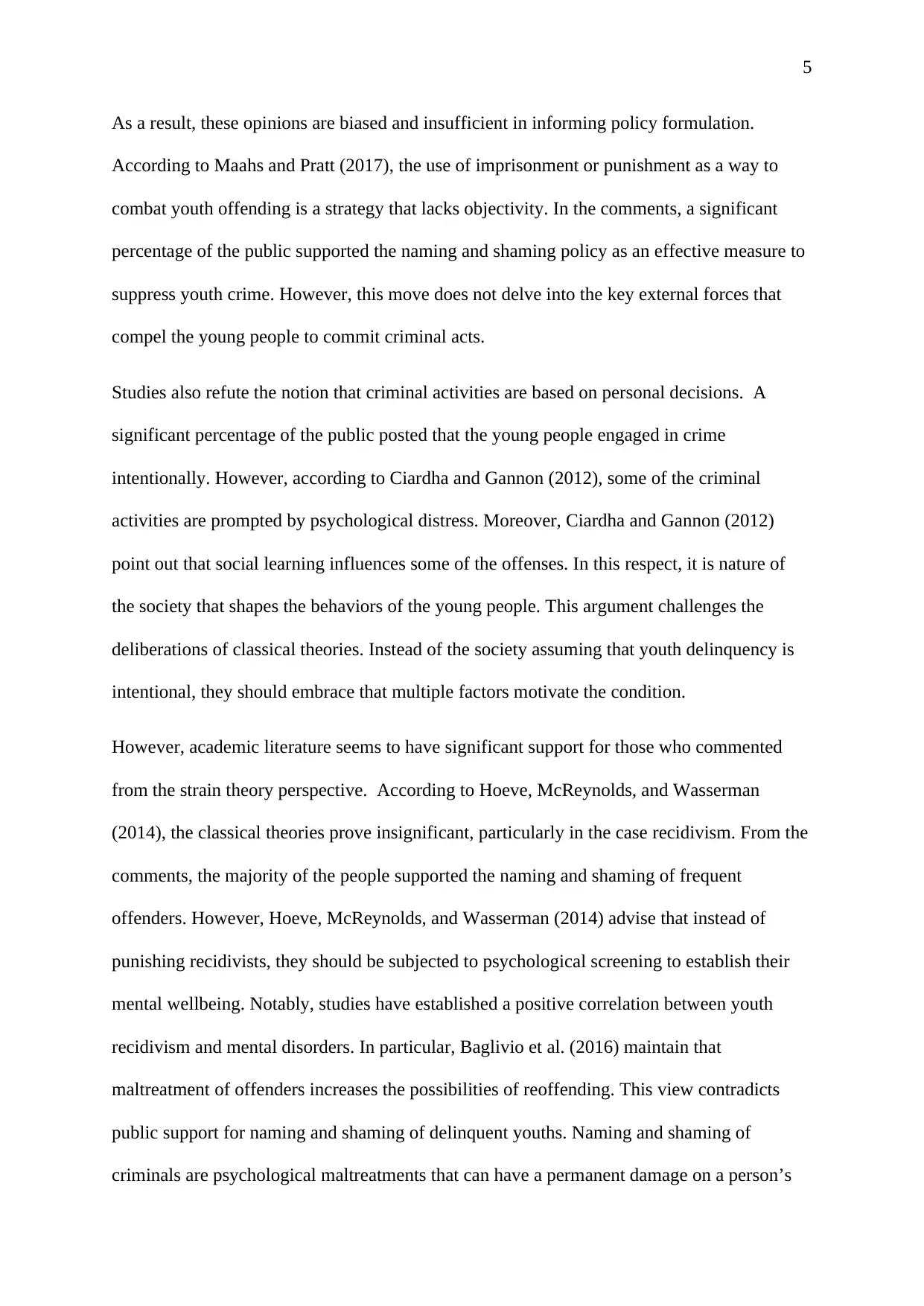
5
As a result, these opinions are biased and insufficient in informing policy formulation.
According to Maahs and Pratt (2017), the use of imprisonment or punishment as a way to
combat youth offending is a strategy that lacks objectivity. In the comments, a significant
percentage of the public supported the naming and shaming policy as an effective measure to
suppress youth crime. However, this move does not delve into the key external forces that
compel the young people to commit criminal acts.
Studies also refute the notion that criminal activities are based on personal decisions. A
significant percentage of the public posted that the young people engaged in crime
intentionally. However, according to Ciardha and Gannon (2012), some of the criminal
activities are prompted by psychological distress. Moreover, Ciardha and Gannon (2012)
point out that social learning influences some of the offenses. In this respect, it is nature of
the society that shapes the behaviors of the young people. This argument challenges the
deliberations of classical theories. Instead of the society assuming that youth delinquency is
intentional, they should embrace that multiple factors motivate the condition.
However, academic literature seems to have significant support for those who commented
from the strain theory perspective. According to Hoeve, McReynolds, and Wasserman
(2014), the classical theories prove insignificant, particularly in the case recidivism. From the
comments, the majority of the people supported the naming and shaming of frequent
offenders. However, Hoeve, McReynolds, and Wasserman (2014) advise that instead of
punishing recidivists, they should be subjected to psychological screening to establish their
mental wellbeing. Notably, studies have established a positive correlation between youth
recidivism and mental disorders. In particular, Baglivio et al. (2016) maintain that
maltreatment of offenders increases the possibilities of reoffending. This view contradicts
public support for naming and shaming of delinquent youths. Naming and shaming of
criminals are psychological maltreatments that can have a permanent damage on a person’s
As a result, these opinions are biased and insufficient in informing policy formulation.
According to Maahs and Pratt (2017), the use of imprisonment or punishment as a way to
combat youth offending is a strategy that lacks objectivity. In the comments, a significant
percentage of the public supported the naming and shaming policy as an effective measure to
suppress youth crime. However, this move does not delve into the key external forces that
compel the young people to commit criminal acts.
Studies also refute the notion that criminal activities are based on personal decisions. A
significant percentage of the public posted that the young people engaged in crime
intentionally. However, according to Ciardha and Gannon (2012), some of the criminal
activities are prompted by psychological distress. Moreover, Ciardha and Gannon (2012)
point out that social learning influences some of the offenses. In this respect, it is nature of
the society that shapes the behaviors of the young people. This argument challenges the
deliberations of classical theories. Instead of the society assuming that youth delinquency is
intentional, they should embrace that multiple factors motivate the condition.
However, academic literature seems to have significant support for those who commented
from the strain theory perspective. According to Hoeve, McReynolds, and Wasserman
(2014), the classical theories prove insignificant, particularly in the case recidivism. From the
comments, the majority of the people supported the naming and shaming of frequent
offenders. However, Hoeve, McReynolds, and Wasserman (2014) advise that instead of
punishing recidivists, they should be subjected to psychological screening to establish their
mental wellbeing. Notably, studies have established a positive correlation between youth
recidivism and mental disorders. In particular, Baglivio et al. (2016) maintain that
maltreatment of offenders increases the possibilities of reoffending. This view contradicts
public support for naming and shaming of delinquent youths. Naming and shaming of
criminals are psychological maltreatments that can have a permanent damage on a person’s
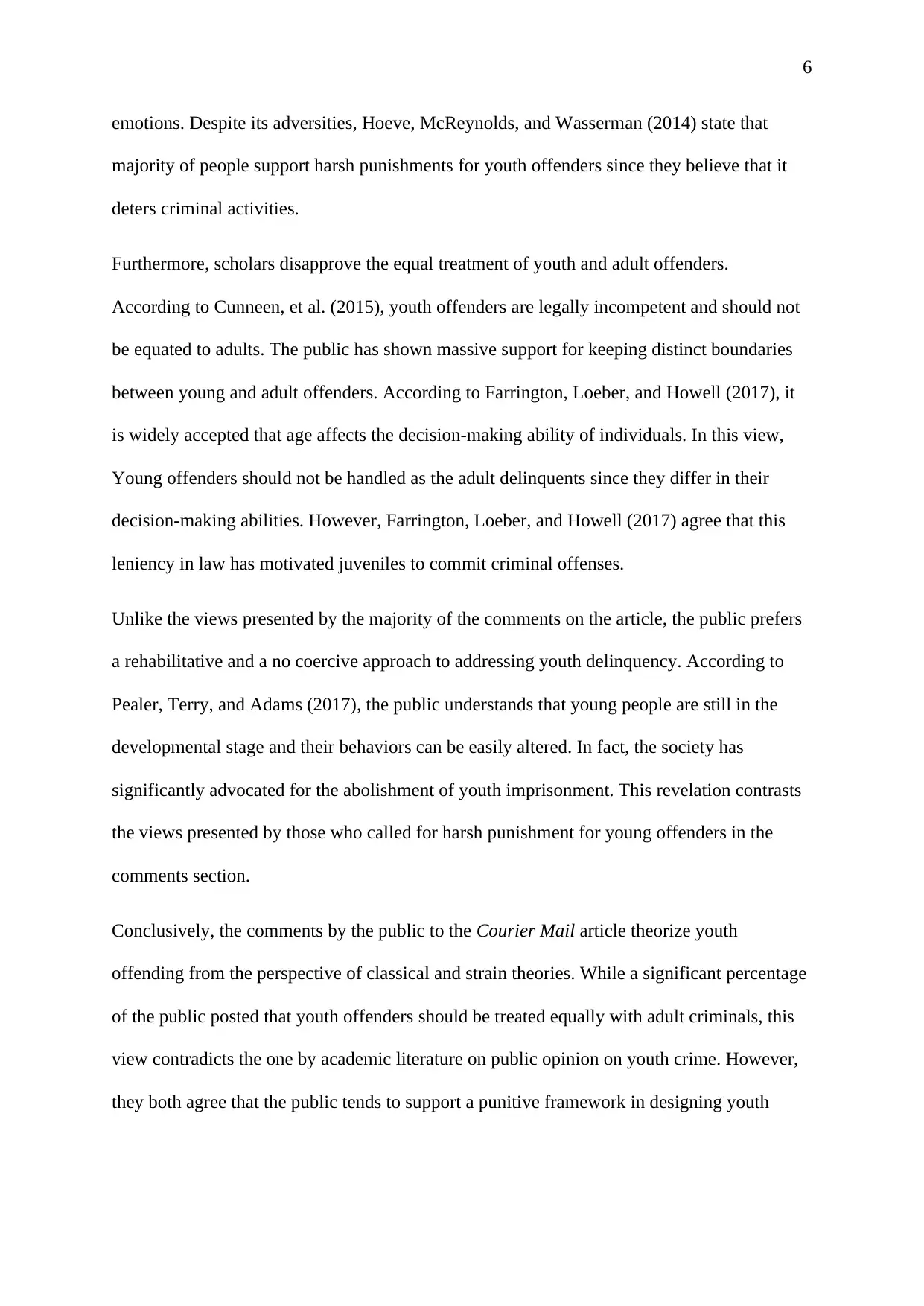
6
emotions. Despite its adversities, Hoeve, McReynolds, and Wasserman (2014) state that
majority of people support harsh punishments for youth offenders since they believe that it
deters criminal activities.
Furthermore, scholars disapprove the equal treatment of youth and adult offenders.
According to Cunneen, et al. (2015), youth offenders are legally incompetent and should not
be equated to adults. The public has shown massive support for keeping distinct boundaries
between young and adult offenders. According to Farrington, Loeber, and Howell (2017), it
is widely accepted that age affects the decision-making ability of individuals. In this view,
Young offenders should not be handled as the adult delinquents since they differ in their
decision-making abilities. However, Farrington, Loeber, and Howell (2017) agree that this
leniency in law has motivated juveniles to commit criminal offenses.
Unlike the views presented by the majority of the comments on the article, the public prefers
a rehabilitative and a no coercive approach to addressing youth delinquency. According to
Pealer, Terry, and Adams (2017), the public understands that young people are still in the
developmental stage and their behaviors can be easily altered. In fact, the society has
significantly advocated for the abolishment of youth imprisonment. This revelation contrasts
the views presented by those who called for harsh punishment for young offenders in the
comments section.
Conclusively, the comments by the public to the Courier Mail article theorize youth
offending from the perspective of classical and strain theories. While a significant percentage
of the public posted that youth offenders should be treated equally with adult criminals, this
view contradicts the one by academic literature on public opinion on youth crime. However,
they both agree that the public tends to support a punitive framework in designing youth
emotions. Despite its adversities, Hoeve, McReynolds, and Wasserman (2014) state that
majority of people support harsh punishments for youth offenders since they believe that it
deters criminal activities.
Furthermore, scholars disapprove the equal treatment of youth and adult offenders.
According to Cunneen, et al. (2015), youth offenders are legally incompetent and should not
be equated to adults. The public has shown massive support for keeping distinct boundaries
between young and adult offenders. According to Farrington, Loeber, and Howell (2017), it
is widely accepted that age affects the decision-making ability of individuals. In this view,
Young offenders should not be handled as the adult delinquents since they differ in their
decision-making abilities. However, Farrington, Loeber, and Howell (2017) agree that this
leniency in law has motivated juveniles to commit criminal offenses.
Unlike the views presented by the majority of the comments on the article, the public prefers
a rehabilitative and a no coercive approach to addressing youth delinquency. According to
Pealer, Terry, and Adams (2017), the public understands that young people are still in the
developmental stage and their behaviors can be easily altered. In fact, the society has
significantly advocated for the abolishment of youth imprisonment. This revelation contrasts
the views presented by those who called for harsh punishment for young offenders in the
comments section.
Conclusively, the comments by the public to the Courier Mail article theorize youth
offending from the perspective of classical and strain theories. While a significant percentage
of the public posted that youth offenders should be treated equally with adult criminals, this
view contradicts the one by academic literature on public opinion on youth crime. However,
they both agree that the public tends to support a punitive framework in designing youth
⊘ This is a preview!⊘
Do you want full access?
Subscribe today to unlock all pages.

Trusted by 1+ million students worldwide
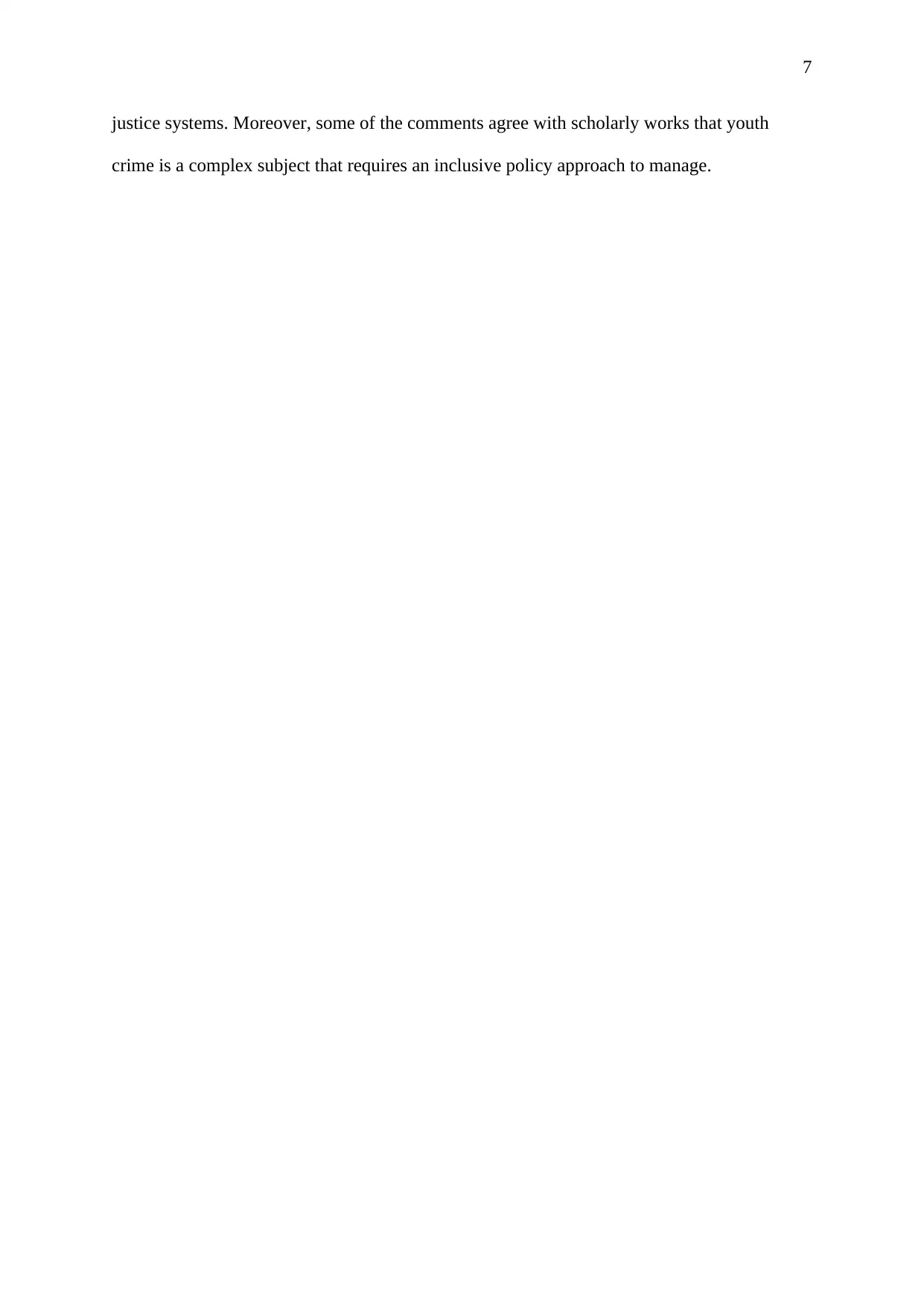
7
justice systems. Moreover, some of the comments agree with scholarly works that youth
crime is a complex subject that requires an inclusive policy approach to manage.
justice systems. Moreover, some of the comments agree with scholarly works that youth
crime is a complex subject that requires an inclusive policy approach to manage.
Paraphrase This Document
Need a fresh take? Get an instant paraphrase of this document with our AI Paraphraser
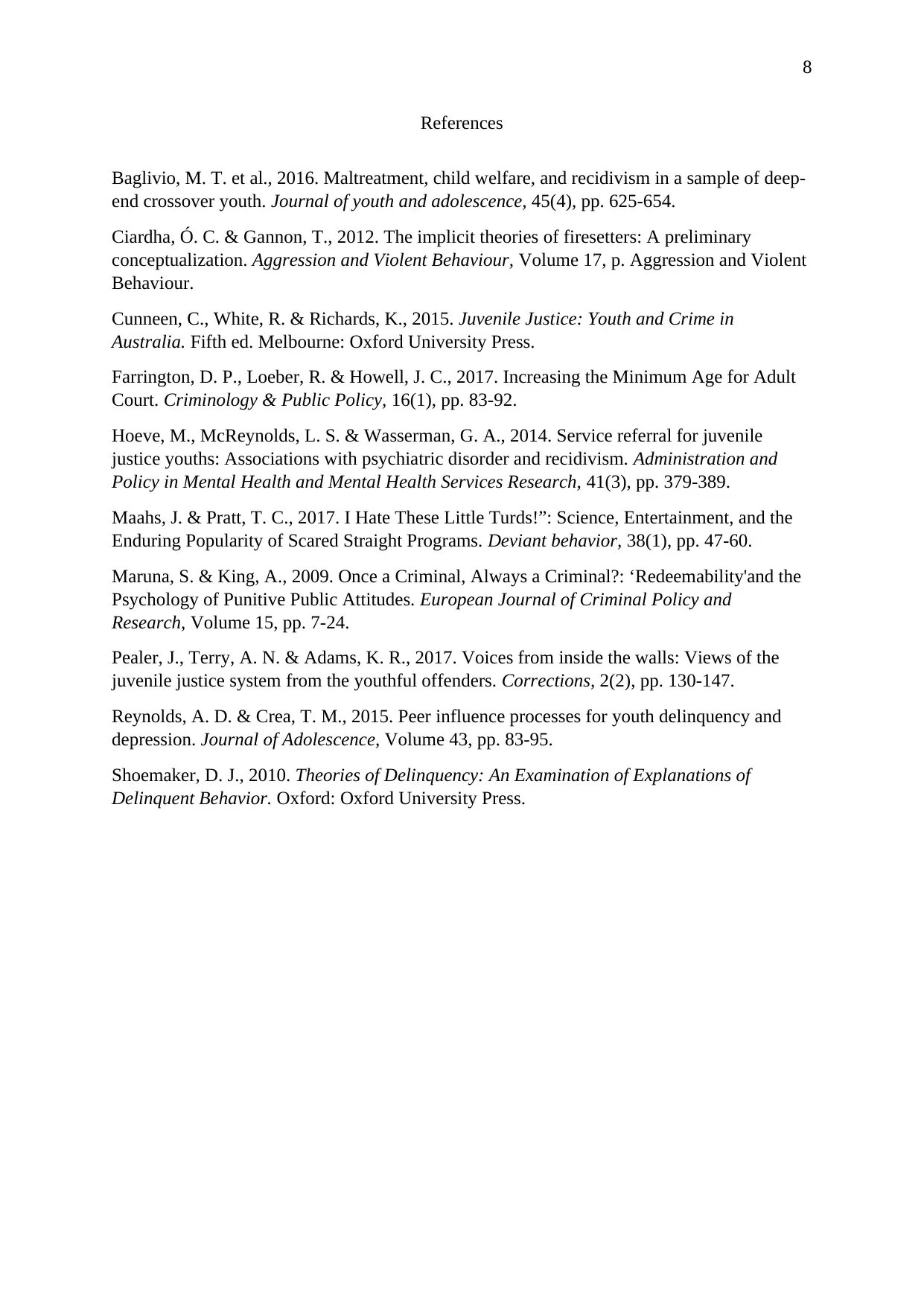
8
References
Baglivio, M. T. et al., 2016. Maltreatment, child welfare, and recidivism in a sample of deep-
end crossover youth. Journal of youth and adolescence, 45(4), pp. 625-654.
Ciardha, Ó. C. & Gannon, T., 2012. The implicit theories of firesetters: A preliminary
conceptualization. Aggression and Violent Behaviour, Volume 17, p. Aggression and Violent
Behaviour.
Cunneen, C., White, R. & Richards, K., 2015. Juvenile Justice: Youth and Crime in
Australia. Fifth ed. Melbourne: Oxford University Press.
Farrington, D. P., Loeber, R. & Howell, J. C., 2017. Increasing the Minimum Age for Adult
Court. Criminology & Public Policy, 16(1), pp. 83-92.
Hoeve, M., McReynolds, L. S. & Wasserman, G. A., 2014. Service referral for juvenile
justice youths: Associations with psychiatric disorder and recidivism. Administration and
Policy in Mental Health and Mental Health Services Research, 41(3), pp. 379-389.
Maahs, J. & Pratt, T. C., 2017. I Hate These Little Turds!”: Science, Entertainment, and the
Enduring Popularity of Scared Straight Programs. Deviant behavior, 38(1), pp. 47-60.
Maruna, S. & King, A., 2009. Once a Criminal, Always a Criminal?: ‘Redeemability'and the
Psychology of Punitive Public Attitudes. European Journal of Criminal Policy and
Research, Volume 15, pp. 7-24.
Pealer, J., Terry, A. N. & Adams, K. R., 2017. Voices from inside the walls: Views of the
juvenile justice system from the youthful offenders. Corrections, 2(2), pp. 130-147.
Reynolds, A. D. & Crea, T. M., 2015. Peer influence processes for youth delinquency and
depression. Journal of Adolescence, Volume 43, pp. 83-95.
Shoemaker, D. J., 2010. Theories of Delinquency: An Examination of Explanations of
Delinquent Behavior. Oxford: Oxford University Press.
References
Baglivio, M. T. et al., 2016. Maltreatment, child welfare, and recidivism in a sample of deep-
end crossover youth. Journal of youth and adolescence, 45(4), pp. 625-654.
Ciardha, Ó. C. & Gannon, T., 2012. The implicit theories of firesetters: A preliminary
conceptualization. Aggression and Violent Behaviour, Volume 17, p. Aggression and Violent
Behaviour.
Cunneen, C., White, R. & Richards, K., 2015. Juvenile Justice: Youth and Crime in
Australia. Fifth ed. Melbourne: Oxford University Press.
Farrington, D. P., Loeber, R. & Howell, J. C., 2017. Increasing the Minimum Age for Adult
Court. Criminology & Public Policy, 16(1), pp. 83-92.
Hoeve, M., McReynolds, L. S. & Wasserman, G. A., 2014. Service referral for juvenile
justice youths: Associations with psychiatric disorder and recidivism. Administration and
Policy in Mental Health and Mental Health Services Research, 41(3), pp. 379-389.
Maahs, J. & Pratt, T. C., 2017. I Hate These Little Turds!”: Science, Entertainment, and the
Enduring Popularity of Scared Straight Programs. Deviant behavior, 38(1), pp. 47-60.
Maruna, S. & King, A., 2009. Once a Criminal, Always a Criminal?: ‘Redeemability'and the
Psychology of Punitive Public Attitudes. European Journal of Criminal Policy and
Research, Volume 15, pp. 7-24.
Pealer, J., Terry, A. N. & Adams, K. R., 2017. Voices from inside the walls: Views of the
juvenile justice system from the youthful offenders. Corrections, 2(2), pp. 130-147.
Reynolds, A. D. & Crea, T. M., 2015. Peer influence processes for youth delinquency and
depression. Journal of Adolescence, Volume 43, pp. 83-95.
Shoemaker, D. J., 2010. Theories of Delinquency: An Examination of Explanations of
Delinquent Behavior. Oxford: Oxford University Press.
1 out of 8
Your All-in-One AI-Powered Toolkit for Academic Success.
+13062052269
info@desklib.com
Available 24*7 on WhatsApp / Email
![[object Object]](/_next/static/media/star-bottom.7253800d.svg)
Unlock your academic potential
Copyright © 2020–2025 A2Z Services. All Rights Reserved. Developed and managed by ZUCOL.


